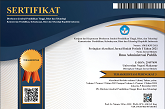Influence of Enso to Variability of Rain Chain at Tropical Cyclon in Southern East Nusa Tenggara
(1) Meteorology, Climatology And Geophysics Agency IV Makassar
(*) Corresponding Author
DOI: https://doi.org/10.26858/jiap.v9i2.12305
Abstract
The Region of East Nusa Tenggara province which is geographically situated around Equator is an area immediately adjacent to place where the growth of tropical cyclones. This research to determine the variability of tropical cyclones that have happened, how the influence of ENSO on the variability of tropical cyclones, and how the impact of tropical cyclones on rainfall in East Nusa Tenggara. In this study, the rainfall data used is represented by 8 stations observations in the region of NTT, namely Kupang, Rote, Sabu, Waingapu, Ruteng, Maumere, Larantuka, and Alor, with period of 19 years ie the assessment year 1996-2014. The data was obtained from Era Interim ECMWF. Tropical cyclone data was obtained from JTWC-Japan and TCWC-Australia, covering a maximum sustained wind data, position, and lifetime cyclone. Rainfall data obtained from Climatological Station of Lasiana-Kupang. Results of the analysis showed that during the study period the total incidence of tropical cyclones in the south of East Nusa Tenggara many as 113 cases, with an average of 6 events cyclones per year and were distributed mainly in the winter between November and April. The results also show that ENSO influence on tropical cyclone variability indirectly to the parameter of tropical cyclones.
Keywords
Full Text:
PDFReferences
Dey, D. (2014). Analysis of the Impact of 2012 Tropical Cyclones on Weather Conditions in the East Nusa Tenggara Region,. Thesis Meteorology Study Program, STMKG, South Tangerang.
Dupe, Z. L. (2003). Tropical Storm and Extreme Weather, in Indonesia,.
Frank, W. M., & Young, G. S. (2007). The interannual variability of tropical cyclones. Monthly Weather Review. https://doi.org/10.1175/MWR3435.1
Holland, G. J. (1997). The maximum potential intensity of tropical cyclones. Journal of the Atmospheric Sciences. https://doi.org/10.1175/1520-0469(1997)054<2519:TMPIOT>2.0.CO;2
Kuleshov, Y., Ming, F. C., Qi, L., Chouaibou, I., Hoareau, C., & Roux, F. (2009). Tropical cyclone genesis in the Southern Hemisphere and its relationship with the ENSO. Annales Geophysicae. https://doi.org/10.5194/angeo-27-2523-2009
Landsea, C. W. (2000). El Nino Southern Oscillation and the Seasonal Predictability. Diambil dari www.aoml.noaa.gov/hrd/Landsea/ el_nino/ index.html
LAPAN. (2004). Report on Events and Effects of Tropical Cyclones in Indonesia. Diambil dari www.Lapanrs.com/result/php
Larasati. (2013). Contributions of Rainfall Affected by Tropical Cyclones on Monthly, Seasonal, and Annual Rainfall in Southern Indonesia in 1979-1998. Yogyakarta: , Faculty of Geography, UGM.
Novrinda. (2014). Study of the Effects of Tropical Cyclones on the Western Pacific Ocean on Rainfall in the East Kalimantan Region (Case Study of Chancu Tropical Cyclone, 11 and 16 May 2006). Thesis, Meteorology Study Program, STMKG,.
Article Metrics
Abstract view : 406 times | PDF view : 53 timesRefbacks
- There are currently no refbacks.
Copyright (c) 2020 Candra Febryanto Patandean

This work is licensed under a Creative Commons Attribution 4.0 International License.
Diterbitkan oleh:
Program Studi Ilmu Administrasi Publik
Program Pascasarjana Universitas Negeri Makassar
JIAP Index By:

This work is licensed under a Creative Commons Attribution 4.0 International License.









